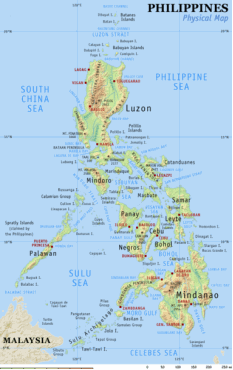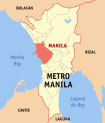|
|
 |  |
 |
|
| |
Location
The Philippine archipelago is geographically located between latitude (approximately) 4o23'N and 21o25'N and longitude (approximately) 112oE and 127oE. The Philippine coastline adds up to 17,500 km. Three prominent bodies of water surround the archipelago: the Pacific Ocean on the east, the South China Sea on the west and north, and the Celebes Sea on the south. This position accounts for much of the variations in geographic, climatic and vegetational conditions in the country.
The topography of the bigger islands - particularly Luzon and Mindanao - is characterized by alluvial plains, narrow valleys, rolling hills and high mountains. The highest mountains are found in Mindanao and Luzon, with the altitudes varying from 1,790 to 3,144 meters. Most of the smaller islands are mountainous in the interior, surrounded by narrow strips of discontinuous flat lowlands which constitute the coastal rims. The shorelines of both large and small islands are irregular.
Capital
Capital The City of Manila (Filipino: Lungsod ng Maynila), or simply Manila, is the capital of the Philippines and one of the municipalities that comprise Metro Manila. The city is located on the eastern shore of Manila Bay on Luzon, the country's largest island. Manila is the second most populous city proper in the Philippines, with more than 1.5 million inhabitants. Only nearby Quezon City, the country's former capital, is more populous. Manila is currently included in the roster of global cities of the world.
Size
It is composed of 7,107 islands, with a land area of 299,764 sq. kilometers. Its length measures 1,850 kilometers, starting from the point near the southern tip of Taiwan and ending close to northern Borneo. Its breadth is about 965 kilometers.
Geography
The Philippines (Filipino: Pilipinas), officially the Republic of the Philippines (Republika ng Pilipinas; RP), is an island nation located in Southeast Asia (historically grouped with Micronesia during American occupation before independence in 1946), with Manila as its capital city. It geographically comprises 7,107 islands situated at the westernmost extreme of the Pacific Ocean called the Philippine Archipelago, with a total land area of approximately 300,000 square kilometers or 116,000 square miles, making it the 72nd largest country by area.
Climates
The local climate is hot, humid, and tropical. The average yearly temperature is around 25°C (78°F) to 32°C (90°F); humidity is 77%. There are three recognized seasons: Tag-init or Tag-araw (the hot season or summer from March to May), Tag-ulan (the rainy season from June to October), and Taglamig (the cold season from November to February). The southwest monsoon (May-October) is known as the "habagat" and the dry winds of the northeast monsoon (November-April) as the "amihan".
|


 |
Population
The Philippines has a population of 89,468,677 (July 2006 est.).
The Philippines is one of the most diverse countries in terms of ethnicity. They identify themselves based on one or several factors such as ancestry, language, religion or a shared history, apart from region. The major ethnic groups in the Philippines are: Tagalog (28.1%), Cebuano (13.1%), Ilocano (9%), Bisaya/Binisaya (7.6%), Hiligaynon Ilonggo (7.5%), Bikol (6%), Waray (3.4%), other (25.3%). (2000 census)
Roman Catholicism, Spain’s lasting legacy, is the predominant religion in the Philippines, with 85% of the population belonging to this faith. About 15 percent is Muslim and these people can be found basically in Mindanao. The rest of the population is made up mostly of smaller Christian denominations and Buddhist.
Population

Flag description: Two equal horizontal bands of blue (top) and red with a white equilateral triangle based on the hoist side. The blue field stands for peace, truth and justice; the red field for patriotism and valor; and the white triangle represents equality and fraternity. In the center of the triangle is a yellow sun with eight primary rays. The eight rays of the sun represent the first eight provinces, Manila, Cavite, Bulacan, Pampanga, Nueva Ecija, Tarlac, Laguna, and Batangas, which revolted against Spanish rule. In each corner of the triangle is a small yellow five-pointed star representing the three major geographical divisions of the country: Luzon, Visayas, and Mindanao.
National Symbols
National Tree: Narra (Pterocarpus indicus)
National Flower: Sampaguita (Jasminium sambac)
National Bird: Philippine Eagle (Pithecophaga jeffery)
National Leaf: Anahaw (Livistona rotundifolia)
National Fruit: Mango (Mangifera indica)
National Fish: Milkfish (Chanos chanos) (Filipino: Bangus)
National Animal: Carabao (Bubalus bubalis) (Filipino: Kalabaw)
National House: Nipa Hut (Filipino: Bahay Kubo)
National Dance: Tinikling
National Costume for Men: Barong Tagalog
National Costume for Women: Baro't Saya
National Sport/Game: Sipa
National Hero: Dr. Jose Rizal
National Anthem: Lupang Hinirang (Land of the Morning)
National Day
Independence Day - 12 June (12 June 1898 was date of declaration of independence from Spain)
History
Before the Spanish explorers came, Indo-Malays and Chinese merchants had settled here. In 1521 the Spaniards, led by Portuguese explorer Ferdinand Magellan, discovered the islands. The Spanish conquistadors established a colonial government in Cebu in 1565. They transferred the seat of government to Manila in 1571 and proceeded to colonize the country. The Filipinos resisted and waged Asia's first nationalist revolution in 1896. On June 12, 1898, Emilio Aguinaldo declared the Philippines independent from Spain and proclaimed himself president. After ruling for 333 years, the Spaniards finally left in 1898 and were replaced by the Americans who continued to colonize the country for another 48 years. The Americans brought over their educational system, their legal system, and their democratic form of government. On July 4, 1946, the Americans finally recognized Philippine independence.
Language
Filipino is the de facto standardized version of Tagalog and the nation's official language. English is widely used as a lingua franca throughout the country, and is the second official language of the country.
Eight (8) major languages are spoken by majority of the Filipinos: Tagalog, Cebuano, Ilocano, Hiligaynon or Ilonggo, Bicol, Waray, Pampango, and Pangasinense. |
 |
|
|
The Republic of the Philippines has a representative democracy modeled after the United States of America's system of government. The 1987 Philippine constitution, adopted during the Corazon Aquino administration, re-established a presidential system of government with a bicameral legislature and an independent judiciary.
The executive branch is headed by the President, Gloria Macapagal-Arroyo since 20 January 2001, who functions as both the head of state and the head of government. The president is also the Commander-in-Chief of the Armed Forces of the Philippines. The president is elected by popular vote to a term of 6 years. During the last elections held last 16 May 2004, President Arroyo and Vice-President Manuel “Noli” De Castro were elected on separate tickets by popular vote for six-year terms.
The bicameral Philippine legislature, the Congress or Kongreso consists of the Senate or Senado (24 seats: one-half elected every three years; members elected by popular vote to serve six-year terms) and the House of Representatives or Kapulungan Ng Mga Kinatawan (214 seats: members elected by popular vote to serve three-year terms. Additional members may be appointed by the President but the Constitution prohibits the House of Representatives from having more than 250 members). |
 |
|
|
Principally light industry and agriculture. Traditional export products are copper, gold, sugar, coconut, and copra. Top non-traditional exports are semiconductors and garments.
Key Economic Indicators:
| Inflation rate (consumer prices) |
3.9% (Jan. 2007) |
| GDP |
US$116.9 billion at current prices (2006 est.) |
| GDP - real growth rate |
5.4% (2006 est.) |
| GDP per capita |
$4,923 (2006) |
| International reserve |
$22.49 billion (Nov. 2006) |
| Fiscal budget (2007) |
PHP1.126-trillion (US$23 billion) |
Natural Resources
Timber, petroleum, nickel, cobalt, silver, gold, salt, copper |
 |
|
|
ACD
The Philippines is a founding member of the ACD. The Philippines is a prime mover in Science and Technology and is co-prime mover in the area of energy.
The Philippines hosted the 2nd Meeting of the ACD Working Group on Energy in 19-20 May 2004.
Other regional groupings
The Philippines is a founding and active member of the United Nations since its inception on October 24, 1945 and is a founding member of the Association of Southeast Asian Nations (ASEAN) and the ASEAN Regional Forum (ARF). The Philippines is also a participant of the East Asia Summit (EAS), an active player in the Asia-Pacific Economic Cooperation (APEC), the Latin Union and a member of the Group of 24. The country is a major non-NATO ally of the U.S., but also a member of the Non-Aligned Movement. Memberships: ASEAN (1967), APEC (1989), AsDB (1966), CP, ESCAP, FAO, G24, G-77, IAEA, IBRD, ICAO, ICRM, IDA, IFAD, IFC, IFRCS, IHO, ILO, IMF, IMO, Inmarsat, Intelsat, Interpol, IOC, IOM, ISO, ITU, ITUC, NAM, OAS (observer), OPCW, UN, UNCTAD, UNESCO, UNHCR, UNHRC, UNIDO, UNMIK, UNMIL, UNMISET, UNOCI, UNU, UPU, ITUC, WCO, WFTU, WHO, WIPO, WMO, WToO, WTrO |
 |
|
|






